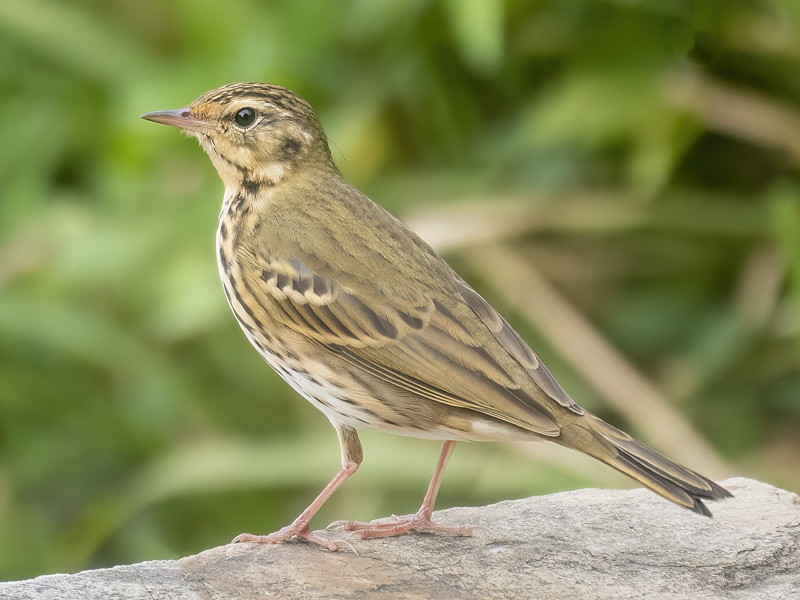Olive-backed Pipit Anthus hodgsoni 樹鷚
Category I. Common winter visitor and passage migrant to wooded, semi-wooded and open-country habitats with wooded areas nearby.
IDENTIFICATION

Nov. 2021, John Clough.
15-17cm. The only pipit likely to be encountered in wooded or semi-wooded habitats. Distinctive face pattern of short, broad whitish supercilium above and behind eye that is buff in front, narrow dark eye stripe, pale spot at rear of cheeks (sometimes indistinct) and dark spot below this. Upperparts have distinct olive tone with light to moderate dark streaks, bold dark streaks on chest that extend down buff-toned flanks where they may become diffuse or remain rather narrow. Call is a distinctive ‘bzzzzzp’ or similar variants always falling in pitch; shorter, lower-pitched and more buzzing than Red-throated Pipit.
VOCALISATIONS
Almost always when in flight but also when perched Olive-backed Pipit gives a distinctive fairly high-pitched buzzing note that falls in pitch terminally. Sometimes in flight over foraging areas gives a very short version of the typical flight call, or one that is close to the alarm note.
The alarm call, always given when perched, is a high-pitched ‘tsip’ or ‘tsee’.
The song is rarely heard in HK in spring.
DISTRIBUTION & HABITAT PREFERENCE
Olive-backed Pipits occur throughout HK, including the outlying islands, in a wide variety of habitats: forests, forest edge, gardens, parks, cemeteries, wet and dry agricultural areas, both open and closed-canopy shrubland and airfield grassland.
OCCURRENCE
Olive-backed Pipit is present from the middle of October to the middle of April, with peak numbers occurring from December to the third week of February (Figure 1). The final week of February apparently sees a departure of a portion of the wintering population, after which numbers fall gradually to the end of spring. Extreme dates of occurrence are 15 September 2012 and 15 May 1977 at Tai Po Kau (though the latest since 1999 is 5 May).
Unsurprisingly for a species occurring at low densities, the highest counts are obtained in surveys of large areas of suitable habitat. The highest count on record is an estimated 150 birds in flocks of six to ten at Lam Tsuen on 9 January 1961. Since 1999 the highest is 86 on 22 December 2015 at Fanling Golf Course.
No change is apparent from the literature. Swinhoe (1861) noted that it was ‘constantly met with’ and later Kershaw (1904), Vaughan and Jones (1913) and Herklots (1953) indicated it was a very common winter visitor.
BEHAVIOUR, FORAGING & DIET
Forages unobtrusively on the ground usually in small parties of up to ten birds that may be scattered around an area. When approached, calling birds fly up into nearby bushes or trees, where they may wait giving an alarm call. Insectivorous, but no details. Both Vaughan and Jones (1913) and Herklots (1967) refer to a preference for foraging in areas of pines, both on the ground and along the branches.
Visible migration has been observed in autumn: on 18 October 1992 ten flew southwest over Tung Ping Chau, in the late afternoon of 6 November 1993 a total of 70 birds flew over Kadoorie ARC from the north during a two-hour period, and on 21 October 1994 over Chek Lap Kok 30 flew northeast, with a further 18 on 3 November the same year. Calling presumed nocturnal migrants have also been recorded at Pak Sha O.
RANGE & SYSTEMATICS
Breeds in Siberia east of the Urals as far as the Sea of Okhotsk, south through Ussuriland and northeast China to north, central and west China, and in Japan; winters in southern Japan, south China west to the Indian subcontinent and south to Thailand, the Philippines and north Borneo (Tyler 2020). In China a summer visitor in areas north of the Chang Jiang (Yangtze River) from southeast Tibet and northwest Xinjiang to northeast China, and a winter visitor mainly south of the Chang Jiang but occasionally as far north as Beijing (Liu and Chen 2020, Birding Beijing 2022).
Two subspecies are recognised. A. h. yunnanensis, which breeds over most of the range south to Nei Mongol and Hebei provinces, China, is considered to occur in HK based on biometrics of birds trapped here and field observation. The nominate, which breeds in the Himalayas and central China north to 38oN and in Japan, is generally distinguished by more heavily-streaked crown, mantle and scapulars, bolder breast streaks that reach further down the belly and more heavily-streaked flanks (Alström et al. 2003).
CONSERVATION STATUS
IUCN: Least Concern. Population trend stable.
Figure 1.

Birding Beijing (2022). https://birdingbeijing.com/the-status-of-the-birds-of-beijing/ (Accessed 13 June 2022).
Herklots, G. A. C. (1953). Hong Kong Birds. South China Morning Post, Hong Kong.
Herklots, G. A. C. (1967). Hong Kong Birds (2nd ed.). South China Morning Post, Hong Kong.
Kershaw, J. C. (1904). List of birds of the Quangtung Coast, China. Ibis 1904: 235-248.
Liu, Y. and Y. H. Chen (eds) (2020). The CNG Field Guide to the Birds of China (in Chinese). Hunan Science and Technology Publication House, Changsha.
Tyler, S. (2020). Olive-backed Pipit (Anthus hodgsoni), version 1.0. In Birds of the World (J. del Hoyo, A. Elliott, J. Sargatal, D. A. Christie, and E. de Juana, Editors). Cornell Lab of Ornithology, Ithaca, NY, USA. https://doi.org/10.2173/bow.olbpip.01
Swinhoe, R. (1861). Notes on the ornithology of Hong Kong, Macao and Canton, made during the latter end of February, March, April and the beginning of May 1860. Ibis 1861: 23-57.
Vaughan, R. E. and K. H. Jones (1913). The birds of Hong Kong, Macao and the West River or Si Kiang in South-East China, with special reference to their nidification and seasonal movements. Ibis 1913: 17-76, 163-201, 351-384.

